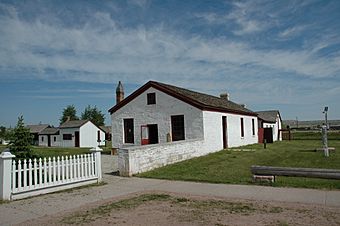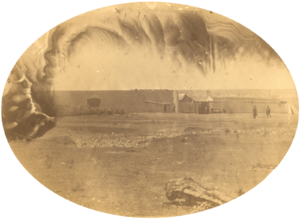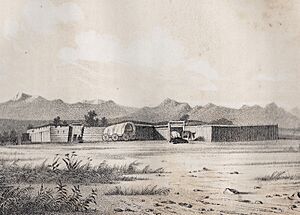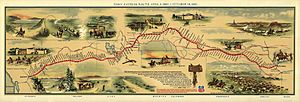Fort Bridger facts for kids
Quick facts for kids |
|
|
Fort Bridger
|
|

Fort Bridger
|
|
| Location | Uinta County, Wyoming |
|---|---|
| Nearest city | Fort Bridger, Wyoming |
| NRHP reference No. | 69000197 |
| Added to NRHP | 1969-04-16 |
Fort Bridger was an important trading post and military fort in the 1800s. It was first built in 1842 in what is now Uinta County, Wyoming. At that time, this area was part of Mexico.
The fort became a crucial stop for pioneers traveling west. Many wagon trains on the Oregon Trail, California Trail, and Mormon Trail stopped here for supplies. Later, the US Army used it as a military base from 1858 until 1890. Today, a small town named Fort Bridger, Wyoming is still located near the historic fort.
Contents
Building Bridger's Trading Post
Who Built Fort Bridger?
The fort was founded by a famous mountain man named Jim Bridger and his partner, Louis Vasquez. Jim Bridger was known for his adventures in the Rocky Mountains. He was often called the "Daniel Boone" of the Rockies.
What Did the Fort Look Like?
In 1843, Bridger described his new fort. It had a blacksmith shop and supplies for travelers. The fort was a simple eight-foot tall fence (stockade) with a corral for animals. Inside the fence were four log cabins. One cabin held Bridger's forge, another was his store, one was for his family, and the last for his partner.
A visitor in 1852, Mrs. Benjamin G. Ferris, saw the fort. She described it as a strong, low log building. It was surrounded by a high wall made of logs standing upright.
Fort Bridger's Location and Importance
The fort was built on Blacks Fork of the Green River. It was in a special spot between different Native American tribes. These included the Snakes, Crows, Sioux, Arapahoes, Cheyennes, and Yutas. This made it a good place for trading.
The Hastings Cutoff and the Donner Party
In 1845, a guide named Lansford Hastings suggested a new route to California. This route, called the Hastings Cutoff, started at Fort Bridger. It promised a shorter path but involved a long, waterless journey across the Great Salt Lake Desert.
The famous Donner-Reed Party followed this dangerous route in 1846. They received a letter from Hastings at Fort Bridger. The letter claimed he had found a "new and better road." Sadly, this cutoff led to many problems for the Donner Party.
Mormons Settle Near Fort Bridger
Mormon Pioneers Arrive
In 1847, the first group of Mormon pioneers reached Fort Bridger. Orson Pratt, one of the pioneers, described the fort. He saw two log houses with dirt roofs and a small fenced yard. Nine Native American lodges were also nearby.
Disputes and Fort Supply
As more Mormons arrived, disagreements started between Jim Bridger and the new settlers. In 1853, a Mormon militia tried to arrest Bridger. They accused him of selling alcohol and weapons to Native Americans, which was against the law. Bridger escaped and left the area for a while.
The Mormons then built their own fort called Fort Supply. It was about 12 miles southwest of Fort Bridger. In 1855, the Mormons took over Fort Bridger. They claimed they bought it for $8,000 in gold coins from Vasquez, Bridger's partner. However, Bridger said he never sold it.
Leaving the Forts
Fort Bridger and Fort Supply were important Mormon outposts for a few years. But in September 1857, the Mormons left both forts. This happened when the U.S. Army, led by Colonel Albert Sidney Johnston, approached during the Utah War.
Fort Bridger Becomes a Military Post
The Utah War and Army Arrival
In 1857, relations between Mormon leaders in Utah Territory and the U.S. government became tense. President James Buchanan sent the United States Army to install a new governor. Colonel Albert Sidney Johnston led an army of 2,500 soldiers.
As the army advanced, the Mormons set fire to the buildings at Fort Bridger. Johnston's army used the remaining stone walls for protection. They spent the winter at a nearby place called Camp Scott. In June 1858, most of the army moved on to Salt Lake City. Two companies of soldiers stayed behind at Fort Bridger.

Building the Army Post
The soldiers at Fort Bridger built new storehouses and living quarters. In 1859, the U.S. government officially made Fort Bridger a military reservation. This meant a large area of land around the fort was set aside for the army.
William A. Carter, the Post Sutler
In 1858, William A. Carter became the post sutler at Fort Bridger. A sutler was a civilian merchant who sold goods to the soldiers. Carter was a very important person at the fort. He ran his store and the post office from the same building. He stayed at the fort for his entire life. After he died in 1881, his wife, Mary Elizabeth Hamilton Carter, took over the business.
Important Treaties and Expeditions
In 1868, a significant event happened at the fort. Chief Washakie signed the Fort Bridger Treaty of 1868 there. This treaty gave Shoshone and Bannock lands in southwestern Wyoming to the U.S. government. It also created the Wind River Indian Reservation.
Fort Bridger troops helped protect the construction of the Overland Route (Union Pacific Railroad). This was a major railroad project. They also guarded the Overland Stage and Mail route. In the 1870s, scientists used the fort as a base for geological expeditions. These included Professor Othniel Charles Marsh from Yale College and Ferdinand Vandeveer Hayden.
The Fort Closes
Eventually, the expansion of railroads across the West made many forts less necessary. Fort Bridger was first closed in 1878. It reopened two years later but finally closed for good in 1890. This was the same year Wyoming became a state.
Preserving Fort Bridger's History
Historic Buildings Today
Today, several interesting old buildings still stand at the historic Fort Bridger site. These include an old Pony Express barn and parts of the Mormon protective wall.
A Wyoming Landmark
On June 27, 1928, the fort's site and its remaining buildings were sold to the Historical Landmark Commission of Wyoming. On June 25, 1933, Fort Bridger was officially dedicated as a Wyoming Historical Landmark and Museum.
Every year, a special event called the Annual Fort Bridger Muzzle Loading Rendezvous is held here. It takes place on Labor Day weekend. People gather to celebrate the history of the fur trade era.
See also
- Charles Howard
- List of the oldest buildings in Wyoming





